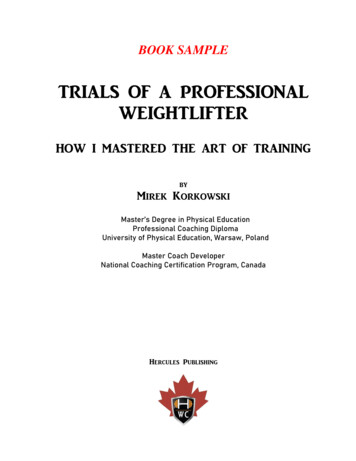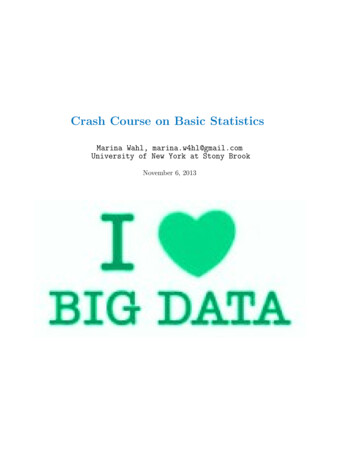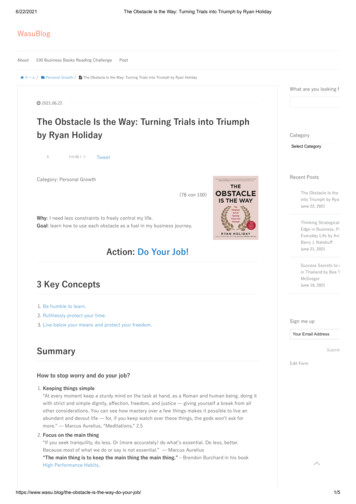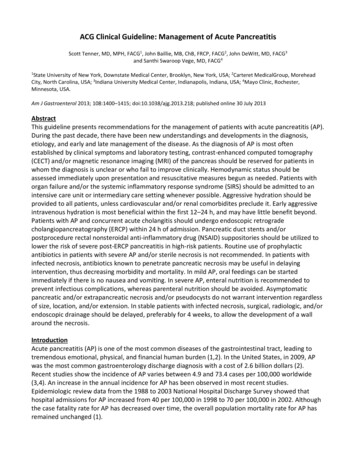
Transcription
BOOK SAMPLETRIALS OF A PROFESSIONALWEIGHTLIFTERHOW I MASTERED THE ART OF TRAININGbyMirek KorkowskiMaster’s Degree in Physical EducationProfessional Coaching DiplomaUniversity of Physical Education, Warsaw, PolandMaster Coach DeveloperNational Coaching Certification Program, CanadaHercules Publishing
TRIALS OF A PROFESSIONAL WEIGHTLIFTER HOW I MASTERED THE ART OF TRAININGAuthor: Mirek KorkowskiEditor: Rafal KorkowskiCopyright 2019 Mirek KorkowskiAll rights reserved.No parts of this publication may be reproduced, stored in a retrieval system, ortransmitted in any form or by any means, electronic, mechanical, photocopying,recording, or otherwise, without the prior written permission of the copyright owner.This book is sold subject to the condition that it shall not, by way of trade or otherwise,be lent, resold, hired out, or otherwise circulated without the publisher’s prior consent inany form of binding or cover other than that in which it is published and without a similarcondition including this condition being imposed on the subsequent purchaser. Underno circumstances may any part of this book be photocopied for resale.Edited by: Rafal KorkowskiPublished by: Hercules PublishingPrinted and Bound in Canada by: First Choice Books and Victoria BinderyCover Image by: Mirek Korkowski, Theresa Brick, Jeane LassenCover Design: CF Design, Winnipeg, MBISBN: 978-1-77136-821-6Special thank you to Rafal Korkowski, Tanna Payne, Jeane Lassen, Theresa Brick, EricMazur, Dariusz Slowik, Josee Morneau and Quinn Nguyen, for allowing us to feature themon the cover and pages of our book.
TABLE OF CONTENTSIntroduction . . . . . . . . . . . . . . . . . . . . . . . . . . . . . . . . . . . . . . . . . . . . . . . . . . . . . . . . . . . . . . 5Chapter 1 – The Weightlifting JourneyThe Early Years (1974-1978) . . . . . . . . . . . . . . . . . . . . . . . . . . . . . . . . . . . . . . . . . . . . . . . . . . . 8Elite Training (1978-1981) . . . . . . . . . . . . . . . . . . . . . . . . . . . . . . . . . . . . . . . . . . . . . . . . . . . . 29Professional Weightlifting (1982-1986) . . . . . . . . . . . . . . . . . . . . . . . . . . . . . . . . . . . . . . . . . 77The Final Years (1986-1988) . . . . . . . . . . . . . . . . . . . . . . . . . . . . . . . . . . . . . . . . . . . . . . . . . 125Chapter 2 – The Successful Training ProgramWeightlifting Facilities . . . . . . . . . . . . . . . . . . . . . . . . . . . . . . . . . . . . . . . . . . . . . . . . . . . . . . . 129Recruitment . . . . . . . . . . . . . . . . . . . . . . . . . . . . . . . . . . . . . . . . . . . . . . . . . . . . . . . . . . . . . . . 135The Age to Begin Strength Training and Olympic Weightlifting . . . . . . . . . . . . . . . . . . . . . 138Understanding Strength Training Principles . . . . . . . . . . . . . . . . . . . . . . . . . . . . . . . . . . . . . 141Strength Training Methods . . . . . . . . . . . . . . . . . . . . . . . . . . . . . . . . . . . . . . . . . . . . . . . . . . . 146Execution of the Snatch . . . . . . . . . . . . . . . . . . . . . . . . . . . . . . . . . . . . . . . . . . . . . . . . . . . . . 152Execution of the Clean & Jerk . . . . . . . . . . . . . . . . . . . . . . . . . . . . . . . . . . . . . . . . . . . . . . . . 163Proper Breathing . . . . . . . . . . . . . . . . . . . . . . . . . . . . . . . . . . . . . . . . . . . . . . . . . . . . . . . . . . . 179Concentration . . . . . . . . . . . . . . . . . . . . . . . . . . . . . . . . . . . . . . . . . . . . . . . . . . . . . . . . . . . . . . 180Sport Nutrition, Muscle Recovery, Regeneration . . . . . . . . . . . . . . . . . . . . . . . . . . . . . . . . . 182Chapter 3 – Training ProgramsBeginner Developmental . . . . . . . . . . . . . . . . . . . . . . . . . . . . . . . . . . . . . . . . . . . . . . . . . . . . 189Intermediate Developmental . . . . . . . . . . . . . . . . . . . . . . . . . . . . . . . . . . . . . . . . . . . . . . . . 213Advanced Competitive . . . . . . . . . . . . . . . . . . . . . . . . . . . . . . . . . . . . . . . . . . . . . . . . . . . . . . 240
ABOUT THE AUTHORMirek Korkowski has more than 40 years’experience practicing and coaching the sportof weightlifting.He started training at the age of 15 andparticipated in 83 sanctioned weightliftingcompetitions, progressing from club toprovincial, national and international levelevents.He achieved his best performance in 1985 witha snatch of 170 kg and Clean & Jerk of 205 kg,for a combined total of 375 kg in the under 100kg bodyweight category.He lifted for the Polish National team in theearly to mid-80’s and began his internationalcoaching career in 1988. It was then that he received an assignment to coach theManitoba Provincial Team and start a Regional Weightlifting Training Center for theCanadian Women’s National Team at the University of Manitoba in Winnipeg,Manitoba.Since then, Mirek has coached numerous national champions and internationalmedalists in Canada. In addition to weightlifting, Mirek has provided strength trainingprograms to elite athletes and high performance teams across a wide range of sportswith tremendous success. To this day he acts as a mentor and resource to multiplenational team programs and continues to provide athletes and coaches alike with theopportunity to succeed.He holds the highest attainable national (NCCP) Olympic Weightlifting coachingcertification and is one of Canadian Weightlifting Federations Master CoachDevelopers. Over the years he has been a major contributor and content provider forthe current coaching certification program used to develop weightlifting coaches inCanada.Mirek received his Master’s Degree in Physical Education and Professional CoachingDiploma in 1983 from the University of Physical Education, Warsaw, Poland.He maintains his active involvement in weightlifting as the master coach of theHercules Weightlifting Clubs in Winnipeg, MB and Nanaimo, BC with his son RafalKorkowski.
INTRODUCTIONThe market is saturated with information regarding “efficient training” and “optimal programs”. Mostbooks, articles and blogs discuss basic psychology and physiology, or describe a wide range ofexercises, training methods, safety protocols and workout variations. In the world of instantgratification, long term planning is rarely discussed.As an Olympic weightlifting sport practitioner of over 40 years, I frequently meet coaches whocontinuously struggle with two problems:1. Technical movement corrections2. Result plateausThe first problem can be avoided if the athlete is properly prepared in the initial stages ofdevelopment. Fully understanding the movements using in-depth analysis becomes critical in order toa) influence correct patterns and b) identify the root causes of deviations.The second problem can be prevented by understanding long term program design. Strength trainingis more than simply lifting as much weight as possible every session, without considering specificgoals of an athlete’s current developmental stage. Program design has to be sophisticated andscientific - taking into consideration the abilities or barriers of each individual. As a training programdeveloper, one must constantly manipulate the training load to encourage continuous resultprogression.So why is this book different?It is designed to benefit weightlifting or multi-sport coaches, personal trainers and athletes byincreasing their knowledge of training periodization and its foundational concepts.The book begins with my personal journey, which shows the trials and tribulations endured in order tobecome a professional weightlifter. The information comes from a meticulous journal of nearly everysession performed during my weightlifting career - full of training logs, event experiences, andreflection notes. Shared for the very first time, you will see how this practical experience hasinfluenced the training methodology which I bestow upon my athletes.It continues with a more in depth description of the various elements necessary to organize asuccessful training program. The proverb “It takes a village to raise a child” is also very relevant tosport. A strong club, training environment, and support systems not only provide the opportunity toperform workouts, but multiple additional benefits as well.Finally, it presents three complete and comprehensive training program examples. These programsare structured based on specific goals and objectives relating to the developmental stage of anathlete. Training seasons are planned according to a predetermined competition schedule. Ultimately,the entire system aims to achieve peak performance for designated major competitions.When developing and evaluating programs I chose to describe them as separate units. This will allowyou to choose the program suitable for your particular situation. The intention is to show you that asperformance levels grow - the details of the analysis and evaluations must also grow.In the end, it is my objective to help you learn, understand and apply the key concepts, so you too canquickly and efficiently organize your training programs. There are no shortcuts to coaching or athleticexcellence – peak performance occurs because you plan for it!
In this chapter, you will be presented with the growth of my career, supported by samples ofactual lifting sessions which I have never before published. From the beginning, I wasencouraged to maintain a training diary. I took this task very seriously. The diary includedevery set and repetition performed in training plus personal reflection notes. Initially, I onlycalculated the number of repetitions performed and total kilograms lifted. As my careerprogressed and knowledge increased, I started to use more elaborate calculations. Thepurpose was to better control the training process. Similarly, my initial notes were mostlymotivational quotes or analysis of the general training system. Later it progressed towardsmore technical, tactical, and sport specific points of my training.My weightlifting timeline is shown across three progressions:THE EARLY YEARSINTRODUCTION TO WEIGHTLIFTING AND THE EARLY DEVELOPMENT PROCESSELITE TRAININGHOW TO BECOME YOUR BESTPROFESSIONAL WEIGHTLIFTINGLIFTING WEIGHTS FOR A LIVINGReflection on the JouRney Knowledge is power – true, but only if you have enough inner strength to apply thatknowledge. It is very easy to deny and discard what you already know. If you follow hopeinstead of reason, you will end up in the middle ranks.Sky is the limit – not true. You set your own limits and must be prepared to perseverethrough many trials in their pursuit.
Polish National rankings (100 kg Category) 1978-1988NameYOBClubSC&JTotalDate1 KOMAR Andrzej56LKS Zjednoczeni Olsztyn180,0227,5407,5832 KRUKOWSKI Piotr64Odra Opole180,0220,0400,0863 PIOTROWSKI Andrzej58Odra Opole177,5215,0392,5884 DANIELAK Pyszard55MRKS Elbląg180,0210,0390,0815 SUCHOCKI Krzysztof54Legia Warsaw170,0215,0385,0836 KUŻEL Jan57Śląsk Tarnowskie Góry172,5212,5385,0857 OSTROWSKI Sylwester58Śląsk Wrocław177,5207,5385,0878 MILIK Marek60MZKS Narew Ostrołęka175,0207,5382,5859 SMOLAK Marek63Legia Warsaw167,5212,5380,08710 KORKOWSKI Mirosław59RKS Ursus Warsaw170,0205,0375,08511 BĄK Jerzy60Górnik Czerwionka165,0210,0375,08712 KORUSIEWICZ Paweł52Górnik Siemianowice162,5210,0372,58413 DYSZKIEWICZ Henryk64Legia Warsaw165,0207,5372,58814 BAŁTOWSKI Tadeusz63LKS Zjednoczeni Olsztyn165,0207,5372,58815 DREWNIAK Jan53Śląsk Wrocław160,0210,0370,08216 KALITYŃSKI Bogdan62Sanoczanka Sanok160,0210,0370,08416 KUŹMICKI Adam58Zawisza Bydgoszcz165,0205,0370,08517 GÓRNY Mieczysław67Sparta Zabrze165,0205,0370,08818 BRUNKA Marian63Stoczniowiec Gdańsk162,5205,0367,58819 MALIŃSKI Henryk51Legia Warsaw165,0200,0365,07920 WALO Witold54Okęcie Warsaw160,0205,0365,08021 GUGAŁA Waldemar54Flota Gdynia155,0210,0365,08222 NOWACKI Leszek57Pogoń Łapy165,0200,0365,08523 MAJDAN Jacek63Lubilinianka165,0200,0365,08524 NOWACKI Marek64AZS-AWF Warsaw170,0195,0365,08725 BANASZAK Piotr64Zawisza Bydgoszcz167,5195,0362,58426 ITTRICH Jan59Flota Gdynia165,0195,0360,08327 KOSIŃSKI Marian65WLKS Siedlce160,0200,0360,08828 SZYMIK Krystian59Górnik Polkowice160,0200,0360,08829 MAŁYSA Stanisław60Legia Warsaw160,0197,5357,58230 DUCZMAN Roman56Legia Warsaw157,5200,0357,585I am frequently asked this question: “What should I do to improve my lifts?”There may be a time when you need to implement a specific exercise or a training method asthe corrective measure. Discovering and working on weaknesses should always be part ofyour developmental plan. My best recommendation? Lift every repetition, of every set, duringeach exercise, with a clearly defined purpose. Always ask yourself - “What’s the objective?Why am I performing this specific movement or action?”Sport is not so much about glory, as it is about hard work and perseverance. A true athlete isconstantly taking steps to better themselves. To me, the memories from the experience,greatly outweigh any regrets I might have over missing out on a particular medal or accolade.Do you have the courage to confront your own dream? Even when you know what youwant, you may not be able to commit your life to it. You will face many obstacles andfrequently have to deal with fears to overcome them. The path won’t be easy. You must be
prepared to have patience in difficult times and never lose faith in your ability. Only then, willyou succeed.Are defeats necessary? Perhaps not necessary, but they will happen. The secret is to get upmore often than you fall. Why then, is it so important to commit to your dream? Once youlearn how to overcome the defeats, you will free yourself from the concept of “impossible” and this will stay with you for the rest of your life.When I look back at my weightlifting career, I was surrounded by many who failed to get whatthey wanted. Some did not want to commit, while others always had an excuse. However,there were an equal number of role models who held strong to their purpose, no matter whatit took. Both groups left lasting impressions that shaped my development. Through it all, Iwas fortunate to have the support of family members, who were happy, proud and genuinelywished me well.My weightlifting journey was tough, but because of it I am resilient. Looking back, I can’timagine pursuing my life in any other way - I would not change a thing. Whether it was themoments of joy, or the hard earned lessons those were the best 12 years of my life.Where ever this book ends up in your collection, accept it as my invitation to you - to wholeheartedly pursue your passion and live the life you desire.In the first chapter we examined how a young person from a small town became successfulenough to make a living from the sport of weightlifting.In this chapter, I want to zoom in on the vital training supports an athlete needs in order tohave the best chance reaching their true potential. The topics touched upon were composedin response to the frequently asked questions within my weightlifting networks.Your individual realities will be composed of many unique situations. These tools are meantto stimulate thought, and should assist any coach or athlete in organizing their trainingenvironment. Evaluate your circumstances and apply as necessary.My agenda is to turn experience into advice, and help you level the playing field. If myanalysis can empower enthusiastic lifters and encourage them to make positive changes totheir programs, I have done my job.Support topics covered:Facilities, Recruitment, Age to Begin Strength Training and Olympic Weightlifting,Strength Training Principles, Strength Training Methods, Proper Breathing,Concentration, Sport Nutrition, Muscle Recovery, Regeneration
The chapter goes on to break down and analyze technique. Each of the lifts is broken downinto phases and supported by visuals:Example: Snatch - Phase 1 – Starting positionSnatch is most efficiently performed using a widergrip. As a starting point, it can be measured as perthe diagram, but adjustments should be applied asneeded based on the individual arm length of theathlete and their joint flexibility.Figure 4: Grip distanceFigure 5a: Starting positionFigure 5b: Starting positionPassive (Relaxed) Starting Position – the lifter interacts with the barbell, but does notengage muscle flexion/extension. The trunk will have an inclination of about 30 degrees inrelation to the ground, shins are inclined forward, and the shoulders are over the barbell (orat a minimum forward distance from it). The head is facing forward with eyes directly ahead.This will promote a linear and extended back position throughout the pull. Starting positionwill have variance based on lifters height, body proportions and grip width.Active Starting Position - preliminary position adjustments to prepare for barbell separationfrom the platform. The athlete lowers their pelvis and moves the knees forward, the angle ofhips, knees and ankle joints decreases. The reason for doing this is to eccentrically stretchthe gluteus maximus and quadriceps muscles. Eccentric stretching results in the activation ofthe receptors in the muscle which initiates the stretch reflex. The response to the stimulus(stretch) is a concentric muscle contraction whose forces can be added to the concentriccontractile forces generated during the pulling phase.
Additional Phases Covered by the book:Phase 2 – The pullPhase 3 – Drop under the barbellPhase 4 – Standing up from receiving positionHere is a sample of one graph, which I use in the book to show various velocities andchanges in joint angles to demonstrate the biomechanical impacts during stages of the lifts.Vertical velocity - defined as the vertical speed at which the barbell is moving upward.Phase 1 ends at 0.5 seconds and amortization (bar passing knees) causes a reduction invelocity. Top velocity is achieved in phase 2 & 3, during the explosive hip extension. Barslows down to a stop just before the 1.0 second mark as the pull reaches the top of the pull.Figure 14: Vertical velocity of the barbell during the SnatchSimilarly, the book breaks down the Clean & Jerk into the following phases for analysis:The CleanPhase 1 – The Starting PositionPhase 2 – The PullPhase 3 – The Drop under the BarbellPhase 4 – Recovering from the SquatThe JerkPhase 1 – The Initial PositionPhase 2 – The DipPhase 3 – The DrivePhase 4 – The Drop under the BarbellPhase 5 – The Split Recovery
My big coaching breakthrough came in November of 1987. I accompanied the Polish team tothe Senior World Championships in Ostrava, Czechoslovakia as an assistant coach. That iswhere I met the Canadian delegation and learned about the coaching position being offeredin Winnipeg, MB, Canada. In the ensuing months, I applied for the position and successfullypassed the selection process.On April 1, 1988 I landed in Montreal and after spending a brief time there, went on toWinnipeg, Manitoba where I started my North American coaching adventure.The Manitoba Weightlifting Association took a very proactive step and decided to hire aprofessional coach. They were already running a provincial training centre at the University ofManitoba and looked to enhance the program. With the additional resources, the goal was tocreate a centralized regional training centre for the Canadian National Teams. The gym hada large open space accommodating 9 solid lifting platforms. Athletes in attendance were ofmixed performance level from novice to intermediate.Right from the beginning, I offered the intermediate athletes a 5 sessions per week trainingroutine. Most male athletes could not commit to more then 3-4 session and despite overallefforts, their results progress was very modest. Those who did choose to attend all sessionsquickly started to show very promising growth. A unique situation was presented to me bythree female athletes: Theresa Brick, Brice Singbeil and Cathy Tascona. They not onlyattended every session but were asking for more.All three lifters were working to prepare for the 2nd Women’s World Championships inJakarta, Indonesia - to be held later that year (November 1988). In short time, I wasorganizing in house training camps to enhance their training to 6-7-8 sessions per week. Nottoo soon after, several leading male athletes also decided to join this enhanced schedule.
Such approach proved to be very successful - in a span of one year we were achievingnational and world level results.Mirek with the Women’s Canadian National Team – Manchester, England, 1989Some highlights included Quinn Nguyen, Theresa Brick and Bryce Singbeil winning goldat the Canadian Championships in 1989, while Cathie Tascona placed 2nd.By 1990 Quinn and Theresa earned best lifter recognition at the Canadian Championships,while new addition Rock Gameiro, won silver medal.Theresa and Bryce participated at the 1991 Women’s World Championships and each placedat a very respectable 5th place!Initially, I relied heavily on my personal training programs, which you can imagine werepredominantly based on the Polish and Eastern Europe training systems. As I started toknow my athletes more, I was able to modify the workouts to meet their needs.With the athletes success, came my personal recognition. In 1989, I was appointed as theHead Coach for the newly formed Canadian Women’s National Team. I also started toactively assist with the junior and senior men’s teams.I was fully committed to offer a solid program based on the developmental stage of eachathlete. My approached paid special attention to individual differences and allowed people toachieve full potential. Because of this, I was constantly forced to adapt the programs and thisexercise was a true passion. Effectiveness of my work was clearly manifested in thecontinued rate of improving results. Quinn, Theresa and Bryce firmly established themselvesat the international level:
Quinn won a bronze medal at the 1993Commonwealth Championships and participated atthe 1991 and 1995 Pan American Games.Quin NguyenTheresa claimed 4th spot at the 1992Women’s World Championships and in1996 in Warsaw won the bronze medal.At the North & Central AmericanChampionships in 1994, Theresaattempted a World Record in the clean& jerk. She was able to clean theweight and missed only on the jerk. Bythat time she was holding all Canadianand Commonwealth records.Theresa BrickBryce Singbeil continued to lift at the consecutive Women’s World Championships regularlyachieving a top 10 ranking.
Mirek with the Canadian Women’s National Team – Training Camp, Winnipeg, 1993To maintain continuity of the team program, I was heavily involved in recruiting newmembers. Those who completed my Developmental and then Intermediate Programs, startedto achieve promising results. At the 1993 Canadian Senior Championships, our 11-memberprovincial team won 5 gold, 2 silver and 1 bronze medals. This included younger generationlifters Manny San Diego and Noreena Bodaglo, who each won gold.In the late 90’s, Charlotte MacEachern andRafal Korkowski started to break juniornational records, both initiating long andproductive lifting careers. Numerous medalsat the Senior Nationals followed.Rafal at the Titan GamesMy son Rafal, lifted at the Pan American Championships in Shreveport, USA and Cali,Columbia, the US Titan Games in Atlanta, and finally at the 2003 World Championships inVancouver, BC. In 2004, he made a strong push to qualify for the Athens, Greece OlympicGames.
Not far behind was Eric Mazur, who in2013 placed 10th at the Junior WorldChampionships in Lima, Peru.Eric MazurThe lifting programs I was offering were not only creating Olympic Weightlifting champions,but contributed greatly to the success of athletes across other sport disciplines. Someathletes used weightlifting solely as to cross train strength/power while others became dualsport participants. To highlight just a few:Garfield Crooks – high jump, OlympianDarius Slowik – discuss, Junior World Championships silver medalistColleen Miller – rowing, World Championships bronze medalistJosee Morneau –World’s Strongwoman multi-winner, World Arm Wrestling ChampionGeoff Gray – football offensive lineman, NFL: Green Packers, NY Jets, Cleveland Browns &CFL Winnipeg Blue BombersJosee MorneauDarius SlowikIn the following pages of this chapter I will present to you a summary of the actual trainingprograms which lead me to the above successes.
The book comes loaded with 70 weeks of ready to implement programming.BEGINNER DEVELOPMENTAL PROGRAM – 24 WEEKSThe young body is an extremely dynamic system with an impressive capacity to adapt anatomically,physiologically, and psychologically to a wide range of functional demands. It’s well known that thestrength training promotes these changes and that the magnitude of these effects is influenced by thetype, intensity, frequency and duration of training. The most noticeable and targeted effect of strengthtraining in athletes is an increase in muscle size and a result an increase in strength itself. However,strength performance is determined not only by the size of the involved muscles, but also by thequality of the muscle, by the ability of the nervous system to appropriately activate the muscles,cardiovascular system role in oxygen transport, skeletal system as a basic structure of the body, anda wide variety of physiological and bio-mechanical mechanisms involved with the activation of muscle.By combining the scientific studies together with practical experience, I’d like to offer you a system ofoptimizing the training process.INTERMEDIATE DEVELOPMENTAL PROGRAM – 26 WEEKSWhen preparing an intermediate level athlete in weightlifting, the yearly plan, or what is commonlyreferred to as Annual Periodization, essentially becomes the most important document from which alldecisions are made. Results obtained from past performances are used to determine the main effortparameters, which are used to determine the duration, frequency and intensity of the training loadsapplied to the athlete over the duration of a one year period. By following the basic principles ofstrength training, a program can be created that provides the maximum amount of fitness with theleast amount of fatigue, which ultimately generates the greatest performance possible.Double PeriodizationThe duration of the program presented below is 6 months and it should be repeated once to cover afull year. This is called double periodization. I further divided the 6 months program into three trainingperiods, Preparatory Period (PP), Competition Period (CP) and Transition Period (TP). The totalvolume of training increases throughout the program. Initially it’s done by an overall increase in thenumber of sets and repetitions in all the exercises used. In the second part of the program in order tomaintain the principle of overload, I reduce the volume of some auxiliary exercises and increase thevolume of the main preparatory exercises. In addition to volume, I increase intensity by increasing theaverage amount of weight on the bar (expected progression) and the number of full lifts, namely thesnatch and the clean & jerk.Program ObjectivesThe Intermediate Developmental Program is designed to achieve perfection in classical exercises thatis the Snatch and the Clean & Jerk. Achievement of peak performance is not the priority and constantimprovement of the result should be noted.Frequent participation in competition would be very beneficial to accomplish the above objective. Inthe program, I didn’t schedule any competition, save the one at the end of the Competition Period. Atthis stage participation at the competition will greatly depend on the local Events Calendar and thusthe availability of the competition. At the end of the program I included Pre-competition Week to beused in order to taper down the training and prepare to compete. Such week can be used at any timeduring the Intermediate Developmental Program.ADVANCED COMPETITIVE PROGRAM – 20 WEEKS
books, articles and blogs discuss basic psychology and physiology, or describe a wide range of exercises, training methods, safety protocols and workout variations. In the world of instant gratification, long term planning is rarely discussed. As an Olympic weightlifting sport pra










